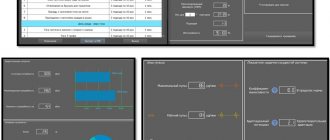Calculate body mass index (BMI) - online calculator for calculating Body Mass Index (Quetelet index)
Body mass index is calculated taking into account a person's height and weight and establishes a correspondence between them. The resulting value will determine your physical condition in the context of your weight.
Body Mass Index formula: BMI = WEIGHT/HEIGHT2
If Body Mass Index:
- up to 16 - clearly expressed body weight deficiency;
- from 16 to 18.50 - lack of body weight;
- from 18.50 to 25 - normal body weight;
- from 25 to 30 - pre-obesity, excess body weight;
- from 30 to 35 - 1st degree obesity;
- from 35 to 40 - 2nd degree obesity;
- more than 40 - morbid obesity, 2nd degree obesity.
It should be remembered that BMI is not universal and is only suitable for the average person not engaged in specialized activities. For example, for athletes this index must be adjusted individually.
How to calculate BMI
You can calculate body mass index in various ways, independently or using free online services. The most famous formulas:
- according to Brock;
- according to Quetelet;
- according to Devin;
- according to Kreff;
- according to Lorenz.
BMI formulas help determine the amount of extra pounds.
BMI according to Brock
Paul Brocque was a French anthropologist and surgeon. He developed a formula for ideal weight, taking into account the natural changes in a person’s body weight over the course of his life. Brock's predecessors did not include in the calculation such data as:
- age category;
- height;
- constitution.
Paul Brokk argued that weight changes with age are natural, and weight that is considered excessive in youth will be acceptable for a more mature person. He proposed the following BMI formula:
normal body weight = height (cm) – 110.
The formula is quite simple, but has a few caveats. For example, people over the age of 40 can subtract not 110, but 100 units.
Over time, Brocca's formula was supplemented by Brugsch and began to look like this:
- normal body weight = height (cm) - 100 (valid for people whose height is less than 165 cm);
- normal body weight = height (cm) – 105 (valid for height 165-175 cm);
- normal body weight = height (cm) – 110 (valid for height over 175 cm).
In addition, Brokk took into account the general constitution of a person and identified 3 types: asthenics with a thin physique, tall stature and narrow bones, hypersthenics with wide bones and developed muscles, and normosthenics with an average physique. The Brocca BMI calculator is taken in its pure form only for normosthenics. Asthenics should subtract 10% from the result obtained, and hypersthenics should multiply the total by 1.1.
Quetelet's formula
Belgian sociologist and statistician Adolphe Quetelet developed the mass index in 1869 to determine the degree of obesity or malnutrition. Quetelet was driven by the desire to find a simple and accessible way to assess the possible risks of the occurrence and development of diseases that are associated with excess weight.
According to the very common Quetelet formula, BMI is equal to the ratio of weight in kilograms to height in meters raised to the second power. Depending on the value obtained, you can see whether the mass is insufficient, acceptable or excessive.
Quetelet did not forget to include age in the calculation, and for each category by year the value must be looked at separately.
At the age of 19-24, people with normal body weight have an index from 19 to 24, then until the age of 34, an acceptable BMI is 20-25. At the age of 35-44 years, the desired BMI can vary from 21 to 26 units. After 45 years, normal BMI is included in the interval 21-27, and after 55 years - 21-28. For people over 65 years of age, an acceptable rate can be from 21 to 29 units.
Lorentz formula
The formula for finding the ideal weight according to Lorentz is quite simple, even simplified. He proposes to find the difference from 2 values: the first is height in centimeters minus 100, and the second is height in centimeters divided by 2. Even simpler, the optimal value that weights should show according to Lorenz’s point of view can be found by dividing height by centimeters by 2 and subtract 25 units from the result.
There are 2 significant limitations for the Lorenz formula: it is only suitable for women whose height is exclusively less than 175 cm. The disadvantage of these calculations is that indicators such as age and body type are not taken into account.
Devin formula
Devin proposed his method for determining ideal weight in 1974. Initially, his goal was to determine the dose of medications, since Demin was a doctor by type of his professional activity. However, his formula quickly gained popularity and is still used to determine BMI.
Calculations for women and men according to Devin are not the same and have a rather complex structure compared to other formulas. Perhaps, due to taking into account many coefficients, his formula gives a more accurate result. It looks like this:
- BMI=50+2.3*(0.394*height-60) – used for men;
- BMI=45.5+2.3*(0.394*height-60) – used for women.
Kref's formula
Kreff improved Brocca's formula by adding age and body composition coefficients. To calculate your BMI, you need to measure not only your height and weight, but also your wrist circumference. To calculate the optimal weight, you need to add 2 values: height in centimeters minus 100 and the number of full years divided by 10. The resulting result should be multiplied by 0.9, and then multiplied by a coefficient depending on the circumference of the wrist:
- 0.9 if wrist circumference is less than 15 cm;
- 1, if the wrist circumference is 15-17 cm;
- 1.1 if the wrist circumference is more than 17 cm.
Ideal weight according to Broca's formula - online ideal weight calculator according to Broca's formula
Using this formula, IV is calculated taking into account height, age and body type.
Some experts note that this technique is most optimal for people with a height of 150 cm to 170 cm.
The ideal weight according to Broca's formula is calculated as follows:
IDEAL WEIGHT = (HEIGHT - K1)*K2
Where, K1 depends on height and is equal to - 100 - for height up to 165 cm; 105 - with height from 165 to 175 cm; 110 - with a height of more than 175.
K2 depends on age and is equal to 0.85 for men; 0.9 - for women.
Your ideal weight
A woman's weight is considered ideal if:
- does not cause discomfort;
- does not limit a woman when performing everyday activities;
- does not cause health problems;
- does not carry potential risks: the likelihood of developing type 2 diabetes, high blood pressure, high cholesterol, heart disease.
There are various ways to determine your ideal weight. The most common are the following:
- By body mass index. If it is normal and there are no concomitant diseases, there is no need to worry.
- Subtract 110 from your height in centimeters.
- Along the fat fold on the abdomen. The norm for women is 2-4 cm.
- Use an online calculator.
The best way to determine the value of your body mass index is to undergo a comprehensive examination using special equipment. It is available in weight loss clinics. Experts will determine the ratio of fat and muscle mass, ideal weight, indicators necessary to determine the state of health and create a diet.
Average height and weight of a person
As reference information for general development, we present the average height and weight values.
For residents of Ukraine, Russia and Belarus, the average height and weight may be as follows:
Ukraine
Men: average height - 1.78 m; weight - 85.5 kg; BMI - 27.0.
Women: average height - 1.66 m; average weight - 72.7 kg; BMI - 26.4.
Belarus
Men: average height - 1.78 m; weight - 84.0 kg; BMI - 26.5.
Women: average height - 1.66 m; average weight - 74.1 kg; BMI - 26.9.
Russia
Men: average height - 1.76 m; weight - 80.2 kg; BMI - 25.9.
Women: average height - 1.65 m; average weight - 72.7 kg; BMI - 26.7.
Source: worlddata.info/average-bodyheight.php
According to the Great Soviet Encyclopedia, for the Caucasian type the average body weight is as follows:
- newborns: boys - 3400/3500 kg, girls - 3200/3300 kg;
- first year of life - plus 6/7 kg;
- at the age of 25-45 years, a period of relative stability of body weight begins.
- The average weight of adult men is 65/68 kg, and 8/10 kg less for women.
It should be noted that averages are dynamic and change over time.
Why do you need to know your BMI?
Data from the World Health Organization indicate that obesity is currently one of the leading diseases in the world.
Doctors successfully fight various kinds of pathologies, infections, and diseases. But the fight against excess weight has not yet shown good results. This is due to an incorrect lifestyle, an abundance of fast food, fatty foods. The consequences of obesity and excess weight are terrifying - type 2 diabetes, a tendency to heart attacks, disruption of the functioning of internal organs. Body mass index may indicate problems occurring in the body:
- an increased value indicates the risk of serious diseases associated with excess weight: hypertension, diabetes, varicose veins, problems of the cardiovascular, digestive systems, internal organs;
- a reduced value is a signal of exhaustion, possible deficiencies of vitamins, minerals, and nutrients. A weakened body is less resistant to external influences. There is a decrease in local immunity and protective reactions. A lack of fat mass and a low BMI may indicate type 1 diabetes, osteoporosis, digestive disorders, mental problems, and eating disorders.
Interpretation of the result
A normal body mass index is between 18.5 and 24.9. The calculation result can be assessed in more detail using the table.
If we turn to the above example, then the calculated body mass index - 28 indicates the presence of excess weight, which is not yet classified as obesity, but already carries an increased risk of morbidity from the “diseases of the century” - cardiovascular, cancer, diabetes. However, one should not rush to conclusions; BMI is not indicative in all cases.
The main advantages of the method of determining normal weight by BMI are its simplicity and versatility; people of any gender and age can use it. However, these advantages have their downside, and the results of the BMI method cannot always be trusted. The main disadvantages of assessing body condition by BMI are the lack of accounting for:
- body type;
- ratio of fat and muscle mass in the body:
- distribution of adipose tissue in the body.
Let's consider each of these shortcomings of the method in more detail.
The influence of body type
In terms of specific gravity, bones are much heavier than muscle tissue, and even more so than adipose tissue, which is the lightest in the body. Therefore, the larger the volume occupied by the musculoskeletal and muscular systems, the less fat there will be for the same body weight.
There are three body types:
- asthenic (ectomorphs);
- normosthenic (mesomorphs);
- hypersthenic (endomorphs).
Ectomorphs have a narrow frame, thin bones and a relatively small volume of muscles. Endomorphs are characterized by a wide skeleton, thick bones and significant muscle mass. Mesomorphs occupy an average position according to these indicators. All these types are variants of the norm. However, the BMI norm does not take into account differences by body type. This method is most suitable for mesomorphs, but asthenics and hypersthenics, using it, can interpret their results incorrectly.
A conditional person with a BMI equal to 28 from the above example may have a completely normal or very slightly higher weight if he is clearly an endomorph. And, conversely, if he is narrow in the shoulders and hips, thin-boned, then a body mass index value of 28 for him may mean he is obese.
Despite the rather large permissible spread of normal BMI values (18.5 - 24.9), the error in determining the normal weight for people of different builds can be quite significant. The error is especially large at the boundaries of this range. So, for example, a person with a hypersthenic physique, having a body mass index of 18.5, will most likely be in a state of exhaustion, and an asthenic person with a BMI of about 25 will be significantly overweight.
Because of this shortcoming of the BMI system, ectomorphs and endomorphs are advised to make adjustments in accordance with the characteristics of their body type, or resort to other methods of estimating body weight.
Percentage of fat and muscle mass
The formula for calculating BMI takes into account only two indicators - height and body weight. However, weight characterizes the condition of the body very conditionally. The figures of people of the same height and weight can differ radically. An athlete with bulky muscles and a small layer of fat can weigh the same as a person of the same height with poorly developed muscles and a large amount of fatty tissue.
For health and appearance, the more important indicator is not weight, but the percentage of fat and muscle in the body. After all, weight is a quantitative indicator that does not take into account the qualitative composition of the body.
Since BMI does not take into account the percentage of fat tissue, it is better not to use this method for people who have a significant predominance of muscle mass over fat mass. Weightlifters and bodybuilders, when trying to determine their ideal weight by body mass index, risk getting results that are far from reality.
Localization of fat deposits
Adipose tissue in the body can be localized in the subcutaneous layer, as well as in the abdominal cavity, where it grows around the internal organs. The most dangerous type of obesity is abdominal, when fat is deposited inside the abdomen. It is abdominal obesity that most often accompanies diabetes mellitus, hypertension, and atherosclerosis, which are the causes of heart attacks and strokes.
Weight classification by BMI does not take into account the type of obesity, and this is one of its main disadvantages. This method recognizes the risk of comorbidities as directly proportional to the degree of obesity. Although in reality, obesity of the abdominal type is more dangerous, even if its degree is lower than with subcutaneous localization of fat.
Abdominal obesity is typical for most men, as well as those women who have an “apple” body type. According to statistics, coronary heart disease, heart attacks, and stroke are more common in men and postmenopausal women. Therefore, persons included in these risk groups should, in addition to determining the acceptable weight by body mass index, also use the following formula for verification: waist circumference in cm divided by height in cm should not exceed 0.5.
Other disadvantages of the method
In addition to the fact that the method of assessing weight by BMI does not take into account body type, percentage and location of fatty tissue in the body, it requires some more adjustments.
For example, this method is not applicable for pregnant women and children. Also, the body mass index may not be correct for women in whom a significant percentage of their body weight is the mass of the mammary glands.
Based on the results of research by American scientists, conclusions have been drawn that cast doubt on the upper limit of normal BMI, which is 24.9. Over the course of many years of observation, it was found that men whose BMI approaches 26 live longer.
BMI for children and adolescents
The problem of excess weight, unfortunately, is relevant not only for adults, but also for the younger generation. It is especially pronounced in families where this trend affected both parents. It is dangerous to turn a blind eye to this; a child’s body is more vulnerable and is just being formed.
The load on the internal organs is higher than normal due to the pressure of fatty deposits, the need of the heart to pump blood more intensively, and the liver to more intensively cleanse it of toxins - will ultimately lead to incurable diseases. Don't forget this.
It is necessary to calculate the body mass index for children and adolescents taking into account their age separately. To obtain correct results, in particular the norms for adolescents, gender and age are included in the calculation, since the young body develops rapidly and gender has a huge influence.
A subjective way of assessment is to compare the external parameters of your child and his peers. But it is better to use an online calculator or formula and check the result against the table to determine the index.
The development scale for boys and girls is different, as evidenced by the figures in the tables, where the deviation from the predicted norm is expressed in %.
BMI for girls
| How many years | 5% (pronounced underweight) | 10% (shortage) | 50% (norm) | 85% (excess) | 95% (dangerously obese) |
| 8 | 12.2 | 13.2 | 15.9 | 18.8 | 22.3 |
| 9 | 13.0 | 13.7 | 16.4 | 19.8 | 23.4 |
| 10 | 13.4 | 14.2 | 16.9 | 20.7 | 23.4 |
| 11 | 13.8 | 14.6 | 17.7 | 20.8 | 22.9 |
| 12 | 14.8 | 16.0 | 18.4 | 21.5 | 23.4 |
| 13 | 15.2 | 15.6 | 18.9 | 22.1 | 24.4 |
| 14 | 16.2 | 17.0 | 19.4 | 23.2 | 26.0 |
| 15 | 16.9 | 17.6 | 20.2 | 23.2 | 27.6 |
| 16 | 16.9 | 17.8 | 20.3 | 22.8 | 24.2 |
| 17 | 17.1 | 17.8 | 20.5 | 23.4 | 25.7 |
| 18 | 17.6 | 18.3 | 20.6 | 23.5 | 25.0 |
BMI for boys
| How many years | 5% (pronounced underweight) | 10% (shortage) | 50% (norm) | 85% (excess) | 95% (dangerously obese) |
| 8 | 12.5 | 14.2 | 16.4 | 19.3 | 22.6 |
| 9 | 12.8 | 13.7 | 17.1 | 19.4 | 21.6 |
| 10 | 13.9 | 14.6 | 17.1 | 21.4 | 25.0 |
| 11 | 14.0 | 14.3 | 17.8 | 21.2 | 23.1 |
| 12 | 14.6 | 14.8 | 18.4 | 22.0 | 24.8 |
| 13 | 15.6 | 16.2 | 19.1 | 21.7 | 24.5 |
| 14 | 16.1 | 16.7 | 19.8 | 22.6 | 25.7 |
| 15 | 17.0 | 17.8 | 20.2 | 23.1 | 25.9 |
| 16 | 17.8 | 18.5 | 21.0 | 23.7 | 26.0 |
| 17 | 17.6 | 18.6 | 21.6 | 23.7 | 25.8 |
| 18 | 17.6 | 18.6 | 21.8 | 24.0 | 26.8 |
In case of strong deviations from the norm for adolescents (-), you should contact your pediatrician to clarify the causes and possible consequences.
Underweight
Typically, a BMI value below 19 indicates underweight. This is no less a serious problem than obesity, ignoring which can lead to anemia, anorexia - diseases dangerous to the body, accompanied by loss of strength, fainting, migraines, disruption of the cardiovascular and digestive systems, weakening of the immune system and the body's defense reactions.
Insufficient body weight in women may indicate the following diseases:
- neuropsychic exhaustion;
- hormonal disorders;
- overwork;
- infectious and viral diseases;
- problems in the gastrointestinal tract;
- eating disorders.
The problem of underweight should not be ignored, as the disease can take a more serious form that is life-threatening. When gaining weight, an integrated approach is important, a special technique that includes proper rest, proper nutrition, moderate physical activity, and work with a psychologist.











